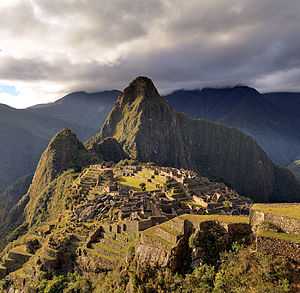Tambo (Incan structure)
 |
| Inca Empire |
|---|
| Inca society |
| Education · Religion · Mythology |
| Architecture · Engineering · Roads |
| Army · Agriculture · Cuisine |
| Inca history |
| Spanish conquest of the Inca Empire |
A Tambo (Quechua: tampu, "inn") was an Incan structure built for administrative and military purposes. Found along Incan roads, tambos typically carried supplies, served as lodging for itinerant state personnel,[1] and were depositories of quipu-based accounting records.
Different types of tambos existed; those that served to lodge the traveling Inca and his entourage (typically wives and state officials), and those that served as relay stations for the chasquis, who were state messengers who ran along state roads.[2]
.jpg)
Tambos were also planned settlements. Architecture and documentary evidence suggest that the functional sizes of the settlements probably corresponded to their capacity to house a population.[3]
Not all modern locations called "tambo" were necessarily formal state way stations, or Inca tampu. Ostensibly, tampu were about a single day's walk apart, with major installations about every five to six days walk.
Remains of tambos are scattered throughout modern-day Peru, Bolivia, Chile, and Colombia.[4] Pedro Cieza de León made numerous references to the tambos in his Crónicas de Peru; in the following passage, Cieza de León described the general uses for the tambos that he learned from native peoples:
"And so there would be adequate supplies for their men, every four leagues there were lodgings and storehouses, and the representatives or stewards who lived in the capital of the provinces took great care to see that the natives kept these inns or lodgings (tambos) well supplied. And so certain of them would not give more than others, and all should make their contribution, they kept the accounts by a method of knots, which they call quipus, and in this way, after the troops had passed by, they could check and see that there had been no fraud."[5]
See also
- Chasqui
- Cultural periods of Peru
- Peruvian Ancient Cultures
- Ollantaytambo
References
- ↑ Provincial Power in the Inka Empire. by Terence N. D'Altroy. 1992. Smithsonian Institution. page 101 ISBN 1-56098-115-6
- ↑ The Wired Professor (2008). "A History of Information Highways and Byways". Retrieved 2008-01-24.
- ↑ Provincial Power in the Inka Empire. by Terence N. D'Altroy. 1992. Smithsonian Institution. page 98. ISBN 1-56098-115-6
- ↑ Owen, Bruce (2006). "The Inka: The Lens Through Which We See the Andean Past". Retrieved 2008-01-24.
- ↑ Cieza de León, Pedro de, The Incas of Pedro de Cieza de León, translated by Harriet de Onis. Norman, OK: University of Oklahoma Press, 1959, p. 105 (Chapter LXXXII).
Further reading
- Adorno, Rolena. “The Depiction of Self and Other in Colonial Peru.” Art Journal, Summer 1990, Vol. 49 Issue 2, p110-19.
- Cieza de León, Pedro de, The Incas of Pedro de Cieza de León, translated by Harriet de Onis. Norman, OK: University of Oklahoma Press, 1959.
- Crow, John A. The Epic of Latin America (Fourth Edition). Berkeley, CA: University of California Press, 1992 (1946).
- Diffie, Bailey W. “A Markham Contribution to the Leyenda Negra.” The Hispanic American Historical Review, Vol. 16, No. 1 (Feb., 1936), 96-103.
- Diffie, Bailey W. Latin-American Civilization: Colonial Period. Harrisburg, PA: Stackpole and Sons, 1945.
- Dobyns, Henry F. and Doughty, Paul L. Peru: A Cultural History. New York: Oxford University Press, 1976.
- Mancall, Peter C. (ed.). Travel Narratives from the Age of Discovery. New York: Oxford University Press, 2006.
- Marett, Sir Robert. Peru. New York: Praeger Publishers, 1969.
- Prescott, William H. History of the Conquest of Mexico & History of the Conquest of Peru. New York: Cooper Square Press, 2000.